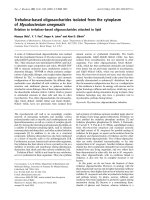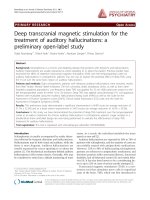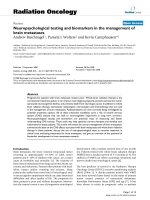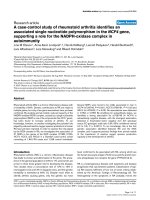Báo cáo y học: "A modified surgical technique in the management of eyelid burns: a case series" potx
Bạn đang xem bản rút gọn của tài liệu. Xem và tải ngay bản đầy đủ của tài liệu tại đây (645.9 KB, 4 trang )
CAS E REP O R T Open Access
A modified surgical technique in the
management of eyelid burns: a case series
Haiying Liu
1
, Kun Wang
1
, Qigang Wang
1
, Shudong Sun
1
and Youxin Ji
2*
Abstract
Introduction: Contractures, ectropion and scarring, the most common sequelae of skin grafts after eyelid burn
injuries, can result in corneal exposure, corneal ulceration and even blindness. Split-thickness or full-thickness skin
grafts are commonly used for the treatment of acute eyelid burns. Plasma exudation and infection are common
early complications of eyelid burns, which decrease the success rate of grafts.
Case presentation: We present the cases of eight patients, two Chinese women and six Chinese men. The first
Chinese woman was 36 years old, with 70% body surface area second or third degree flame burn injuries involvi ng
her eyelids on both sides. The other Chinese woman was 28 years old, with sulfuric acid burns on her face and
third degree burn on her eyelids. The six Chinese men were aged 21, 31, 38, 42, 44, and 55 years, respectively. The
38-year-old patient was transferred from the ER with 80% body surface area second or third degree flame burn
injuries and third degree burn injuries to hi s eyelids. The other five men were all patients with flame burn injuries,
with 7% to 10% body surface area third degree burns and eyelids involved. All patients were treated with a
modified surgical procedure consisting of separation and loosening of the musculus orbicularis oculi between
tarsal plate and septum orbital, followed by grafting a large full-thickness skin graft in three days after burn injury.
The use of our modified surgical procedure resulted in 100% successful eyelid grafting on first attempt, and all our
patients were in good condition at six-month follow-up.
Conclusions: This new surgical technique is highly successful in treati ng eyelid burn injuries, especially flame burn
injuries of the eyelid.
Introduction
Eyelid involvement is common in facial burns. Treat-
ment of eyelid burn injuries requires great care for the
protection of the cornea. Burns damage tissues primarily
by denaturing and coagulating cellular proteins and
through vascular ischemic damage [1]. The most com-
mon etiologic agents of eyelid burns include local ther-
mal an d chemical burns a nd systemic burn s [1,2].
Patients with burns involvingthefaceoftenalsohave
burns to the eyelids. Approximately 15% to 20% of
patients with facial burns exhibit ocular injury. Most
eyelid burns are the result of exposure to fire. In devel-
oping countries, 80% of chemical burns were due to
industrial and/or occupational exposure. Approximately
60% of eyelid burns deve loped eyelid co ntractures and
eyelid ectropion, leading to loss of protection of cornea
[3]. The effects of corneal exposure include corneal
ulcerations, corneal perforation, cataracts, glaucoma,
scarring of the cornea, and ultimately loss of vision.
These complications are more often caused by direct
contact with chemicals. A third of patients who sustain
chemical burn injuries of the eye require corneal trans-
plants. However, the success rate of corneal transplants
is less than 50%, often requiring multip le attempts
before success is achieved. About 15% of eyelid burn
patients can become blind if not treated promptly [3,4].
Early management is critical in t he eyelid burn patient,
including non-surgical measures such as the use of arti-
ficial tears and moist gauze covering of the eyes to pre-
vent drying of the cornea. Early eyelid surgical
management is critical for the protection of the cornea.
Delay in surgical management may result in eyelid con-
tractures and eyelid ectropion after grafting. We used a
modified surgical method to treat eyelid burn injuries in
eight patients. Our surgical procedure successfully
* Correspondence:
2
Qingdao Central Hospital, Qingdao, Shandong Province 266042, PR China
Full list of author information is available at the end of the article
Liu et al. Journal of Medical Case Reports 2011, 5:373
/>JOURNAL OF MEDICAL
CASE REPORTS
© 2011 Liu et al; licensee BioMed Central Ltd. This is an Open Access article distributed under the terms of the Creative Commons
Attribution License (http://creativec ommons.org/licenses/by/2.0), which permits unrestri cted use, distribution, and reproduction in
any medium, provided the original work is properly cited.
prevented eyelid contractures, eyelid ectropion, and the
need for cornea transplantation. All our patients had
good eye vision and cosmetic appearance at six-month
follow-up.
Case presentation
Case 1 was a 36-year-old Chinese woman who was diag-
nosed with flame burn three hours after injury. Her
injuries were second o r third degree burns involving the
total head, anterior and posterior torso, both arms and
parts of both thighs. Her blood pressure was 90/60
mmHg. Liquid resuscitation and antibiotics were used
upon admission. Our patient was in a stable condition
after resuscitation. Eyelid surgery was performed on day
three.
Case 2 was a 38-year-old Chinese man who was trans-
ferred from the emergency room (ER) 48 hours after
flame burn injury. The burnt area was 80% of his body
surface area (BSA), involving his head and neck, t orso,
both arms and parts of both legs. A total of 50% of the
burn area was third degree. He was treated by oxygen
inhalation, liquid resuscitation and antibiotics in the ER,
and had a stable vital condition. On day three, skin graft
surgery was performed.
Cases3,4,5,6and7wereallChinesemenaged21,
31, 42, 44 and 55, respectively; flame burn was diag-
nosed three to five hours after injury with 7% to 10%
BSA third degree burns involving the face, neck, both
forearms and both hands.
Case 8 was a 28-year-old Chinese woman who spilled
sulfuric acid on her face five hours previously. She was
diagnosed as having a third degree burn on her face and
second degree burns on both hands.
All eight patients had second and/or third degree eye-
lid burns, and five had partial musculus orbicularis ocul i
burns, but with the tarsal plate intact. The patients’ ages
ranged from 21 to 55 years o ld, with a median age of
37. All our patients were hospitalized and treated with
artificial tears, moist gauze eye coverings and antibiotic
oculentum application to eyes twice a day for three
days. Eyelid surgery was performed three days after
burn injury. Surgery after three days of burn injury can
avoid a large amount of plasma exudation that can
influence skin graft success. Local anesthesia was
induced with 1% lidocaine. A horizontal incision was
made 2 to 3 mm above and parallel to the palpebral
margin. The two sides of the incision passed t he inner
and outer oculi medialis by 5 mm. The peri-orbi tal
areas were dermabraded. The musculus orbicularis oculi
was separated and loosened between the tarsal plate and
septum orbital using a fine pa ir of sciss ors. This techni-
que can loosen the musculus orbicularis oculi, enlarging
the eyelid space by 5 mm. A 15 to 20 mm wide and
one-fifth longer th an eyelid, full-thickness skin graft was
graftedandfixedwith3-0suture.Theskingraftswere
harvested from an inguinal area or thoracic area. The
wound was cleaned and covered with 10% povidone-
iodine gauze. Surgical sutures were removed at post-
operative day 10 (Figure 1, Figure 2, Figure 3 and 4).
Surgery was successfully performed on both eyes of all
eight patients. The appearance, and opening and closing
of eyelids were satisfacto ry and the protective functions
were fully restored. There was no eyelid contracture and
ectropion at six-month follow-up. One patient’spre-
operative and post-operative follow-up pictures are
included (Figure 5, Figure 6, Figure 7, Figure 8 and 9).
Discussion
Eyelid involvement is common in f acial burns. Eyelid
burn injuries, especially b y chemical contact, are critical
emergencies. Priority is always given to eye closure, oral
continence, neck and limb movement [5,6]. The acute
management includes gentle eyelid and eyelash hygiene
to prevent crusting. Topical ophthalmic antibiotic oint-
ments and artificial tears should be applied frequently.
The upper eyelid is responsible for moistening the cor-
nea. Patients with eyelid burns should be examined
daily, especially while asleep. When the patient is asleep
the voluntary component of lid closure is lost and the
cornea may be p artially exposed. Tarsorrhaphy was
advocated for corneal protect ion in the past, but it can-
not prevent lid retraction in the long term. Tarsorrha-
phy is not a substitute for timely skin grafting. The
optimal time to perform a skin graft on an eyelid for
deep second or third degree burn injury is still contro-
versial. Most surgeons suggest grafting as early as possi-
ble. Early skin grafting increases the risks of infec tion
and complications. However, delayed skin grafting also
increases the risk of eyelid hypertrophic scarring, asym-
metry and other deformities that can lead to eyelid con-
tractures and result in cornea exposure [ 7-9]. We
performed skin grafting at three days after burn injury.
This prevented excessive exudation and contributed to
Figure 1 Surgical procedures of eyelid skin graft.Incisionwas
made by the dashed line.
Liu et al. Journal of Medical Case Reports 2011, 5:373
/>Page 2 of 4
skin grafting success. Our procedure also prevented
large and f irm scar formation and further eyelid con-
tractures in the future [9,10]. The benefits of t he new
tech nique include a lower graft re tracti on rate, resulting
in better corneal protection. Loosening and separating
of the orbicularis muscle ensures that a big graft can be
applied. This procedure makes an artificial fold on the
graft, allowing extra skin for future graft contracture
while still preserving the ability to close the eye ade-
quately. We widen the grafting area by separating and
loosening the musculus orbicularis oculi, gaining 5 mm
Figure 2 Separation until tarsal plate with graft skin on upper
lid.
Figure 3 Separation until tarsal plate with graft skin on lower
lid.
Figure 4 Closed eye covered after grafting.
Figure 5 Patient pre-operative view.
Figure 6 Open eyes, seven months after surgery.
Figure 7 Closed eyes, seven months after surgery.
Figure 8 Open eyes, 12 months after surgery.
Figure 9 Closed eyes, 12 months after surgery.
Liu et al. Journal of Medical Case Reports 2011, 5:373
/>Page 3 of 4
of space by this technique (one-fifth longer than eyelid),
which can elongate the graft by 10 mm for optimal
results. We do not recommend creating more space
than this, as this will cause more surgical trauma for no
additional benefit. With this modified method, ectropion
can be prevented even with future contraction of the
wound. The use of full-thickness instead of split-thick-
ness skin grafts, such as in our procedure, can contri-
bute to lower ectropion incidence and lower corneal
exposure [7]. The thicker the graft, the less the potential
for contracture. Other advantages include increase resis-
tancetotraumaoverthingraftsandlessdistortion
functionally and cosmetically [6]. We collected these
eight cases into one case series because the surgical
management of the eyelid injuries was the same,
although the systemic managements of thes e patien ts as
different according to the injury area and type. Follow-
ing our surgical procedure, our patients could close
their eye s freely, with little or no eyelid retraction. The
grafted eyelids al so appeared more cosmetically accepta-
ble in double folds instead of a single fold because larger
skin grafts were used. Only one patient in this case ser-
ies had a chemical burn injury. Thus, we need to assess
the efficacy of this modified surgical procedure in more
chemical burn injury patients in the future.
Conclusions
This new technique is beneficial in the treatment of eye-
lid burn injuries, especially in the treatment of flame
eyelid burn injury. The results for chemical burn injuries
need more testing.
Consent
Written informed consent was obtained from the
patients for publication of this case report and any
accompanying images. A copy of the written consent is
available for review by the Editor-in-Chief of this
journal.
Acknowledgements
We sincerely appreciate the superb assistance of Cheltus Cheyuo MD of the
Feinstein Institute for Medical Research, New York for help writing the
revised manuscript.
Author details
1
Burn Center, Weifang People’s Hospital, Weifang Medical School, Weifang,
Shandong Province 265000, PR China.
2
Qingdao Central Hospital, Qingdao,
Shandong Province 266042, PR China.
Authors’ contributions
HL, KW and YJ designed the surgical procedure. QW and SD worked as
team members. YJ wrote the manuscript. All authors read and approved the
final manuscript.
Competing interests
The authors declare that they have no competing interests.
Received: 21 August 2010 Accepted: 15 August 2011
Published: 15 August 2011
References
1. Tuft SJ, Shortt AJ: Surgical rehabilitation following severe ocular burns.
Eye 2009, 23:1966-1971.
2. Malhotra R, Sheikh I, Dheansa B: The management of eyelid burns. Surv
Ophthalmol 2009, 54:356-371.
3. Stern JD, Goldfarb IW, Slater H: Ophthalmological complications as a
manifestation of burn injury. Burns 1996, 22:135-136.
4. Kuckelkorn R, Schrage N, Keller G, Redbrake C: Emergency treatment of
chemical and thermal eye burns. Acta Ophthalmol Scand 2002, 80:4-10.
5. Burd A, Ahmed K: The acute management of acid assault burns: a
pragmatic approach. Indian J Plast Surg 2010, 43:29-33.
6. Apostolos D, Mandrekas AD, Zambacos GJ, Anastasopoulos A: Treatment of
bilateral severe eyelid burns with skin grafts: an odyssey. Burns 2002,
28:80-86.
7. Lille ST, Engrav LH, Caps MT, Orcutt JC, Mann R: Full-thickness grafting of
acute eyelid burns should not be considered taboo. Plast Reconstr Surg
1999, 104:637-645.
8. Iwuagwu FC, Wilson D, Bailie F: The use of skin grafts in postburn
contracture release: a 10-year review. Plast Reconstr Surg 1999,
103:1198-1204.
9. Bruns AD: Facial burns.[ />overview].
10. Liebau J, Schulz A, Arens A, Tilkorn H, Schwipper V: Management of lower
lid ectropion. Dermatol Surg 2006, 32:1050-1057.
doi:10.1186/1752-1947-5-373
Cite this article as: Liu et al.: A modified surgical technique in the
management of eyelid burns: a case series. Journal of Medical Case
Reports 2011 5:373.
Submit your next manuscript to BioMed Central
and take full advantage of:
• Convenient online submission
• Thorough peer review
• No space constraints or color figure charges
• Immediate publication on acceptance
• Inclusion in PubMed, CAS, Scopus and Google Scholar
• Research which is freely available for redistribution
Submit your manuscript at
www.biomedcentral.com/submit
Liu et al. Journal of Medical Case Reports 2011, 5:373
/>Page 4 of 4









